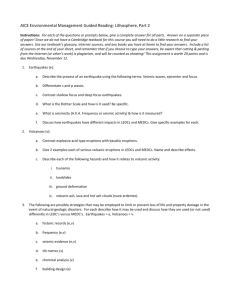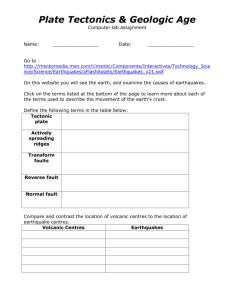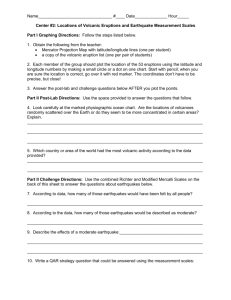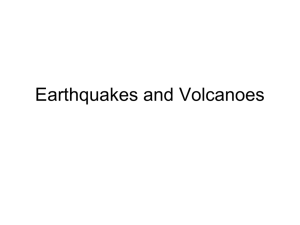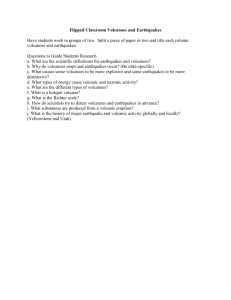7. Endogenic Processes - Volcanic, Tectonic and Orogenic
advertisement
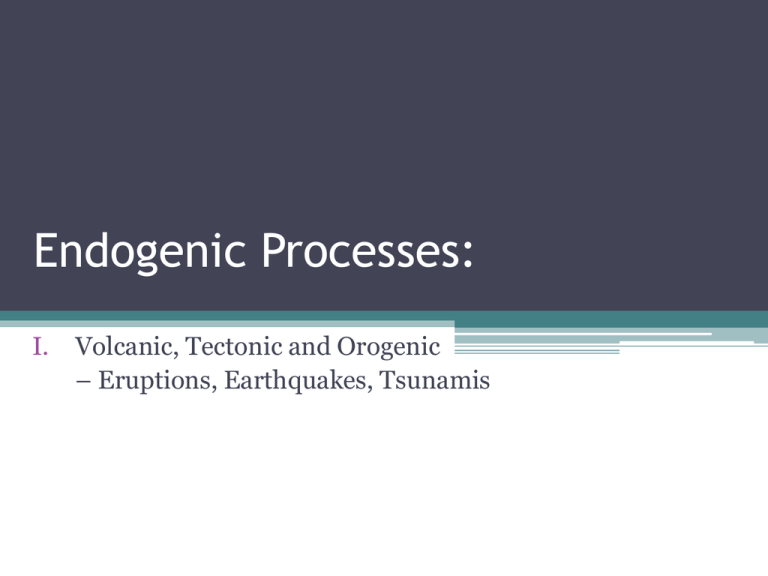
Endogenic Processes: I. Volcanic, Tectonic and Orogenic – Eruptions, Earthquakes, Tsunamis Geomorphology – a major subfield of geography and Geology – Study of landforms – their origin and change over time and space Geomorphic Processes: Physical processes which create and modify landforms on the surface of the earth Are landform changes gradual or abrupt? These processes operate in episodic manner – with earthquakes and volcanic eruptions causing a punctuated equilibrium Geomorphic Processes: A. Endogenic (Endogenous) B. Exogenic (Exogenous) Relates closely to the Rock Cycle A. Endogenic Processes Endogenic Processes are large-scale landform building and transforming processes – they create relief. 1. Igneous Processes a. Volcanism: Volcanic eruptions Volcanoes b. Plutonism: Igneous intrusions 2. Tectonic Processes (Also called Diastrophism) a. Folding: anticlines, synclines, mountains b. Faulting: rift valleys, graben, escarpments c. Lateral Faulting: strike-slip faults Earthquakes evidence of present-day tectonic activity Igneous Processes – involving eruptions or emplacements of molten magma from the earth’s mantle (extrusive and intrusive igneous rocks) Volcanism : It refers to the extrusion of rock matter from earth’s subsurface to the exterior, and the creation of surface terrain features – Volcanoes are mountains or hills that form in this way. How Volcanoes are Formed About 95% of active volcanoes occur at the plate subduction zones and at the mid-oceanic ridges. Subduction is a process of plate tectonics where one lithospheric plate is pushed below another. The other 5% occur in areas associated with lithospheric hot spots. Where are Volcanoes Found? Where are Volcanoes Found? Convergent Plate Boundaries Subduction Zones Oceanic-oceanic island arcs Aleutian, Kurile, Marianas, Tonga Oceanic-continental active continental margins South America, North America, Central America, Kamchatka Divergent Plate Boundaries Mid-Oceanic Ridges and Rift Valleys Continental-Continental Continental rifts East Africa, Red Sea-Gulf of Aqaba Oceanic-Oceanic Oceanic rifts Mid-oceanic ridges, spreading sea floors, volcanic islands Iceland, Azores Intraplate “Hotspots” or “Mantle Plumes” Oceanic islands Hawaii, Emperor Seamount Chains – Pacific Ocean Continental Yellowstone, Wyoming, USA A volcano is generally a conical shaped hill or mountain – some active, others dormant. Built by accumulations of lava flows, and tephra (or fragmented rock material ejected by a volcanic explosion -- also called pyroclastic material, ranging in size from volcanic ash, cinder to volcanic “bombs” Volcanic eruptions Explosive vs. Effusive, depends mainly on temperature and chemical differences in the magma silica-rich felsic magma has greater potential for explosive eruption basalt-based mafic magma leads to more effusive eruption http://www.youtube.com/watch?v=uZp1dNybgfc&feature=fvw Volcanic Landforms Volcanic activity gives rise to such topographic features as: Lava Flows ropy pahoehoe, and blocky aa Volcanic Islands • related to hot spots, as in Hawaii • related to divergent plates and seafloor spreading, as in Iceland Volcanic Mountains (a) Shield, (b) Cinder Cone, (c) Composite Cone or Stratovolcano and (d) Plug Dome volcanoes + (e) Caldera SHIELD VOLCANOES Shield volcanoes are volcanic mountains built up by the eruption of fluid, basaltic lava flowing out of a central vent. They have broad bases with very gentle slopes The largest shield volcano on Earth is Mauna Loa in Hawaii which rises from its base on the seafloor to a height of 17 km (10.5 miles). CINDER CONE VOLCANOES A cinder cone is a steep, conical hill of volcanic fragments that accumulate around and downwind from a vent Cinder cones range in size from tens to hundreds of meters tall. Amboy Crater, southeastern California COMPOSITE VOLCANOES or STRATOVOLCANOES Stratovolcanoes are very tall, 1000s of feet, and are typical cone-shaped mountains Produced by alternating layers of felsic and mafic magmas, hence stratas and “Stratovolcano” Most have snow, ice and even glaciers at top because of their heights Eruptions are mostly explosive, but often also effusive Examples: Mt. Shasta, Mt. Hood, Mt. Rainier, Mt. Fujiyama, Mt. St. Helen Mt. St. Helens a typical composite volcano (before and after 1980 eruption) PLUG DOME VOLCANOES These volcanoes produce thick pasty lava The lava cools into angular blocks after it is slowly squeezed out of the vents Mt. Lassen, northern California Caldera The most explosive type of volcano is the caldera. The cataclysmic explosion of these volcanoes, and subsequent subsidence, leave a huge circular depression on Earth's surface. Wizard Island and Crater Lake, Oregon WORLD’S LARGEST CALDERA Lake Toba, Indonesia Largest recognized caldera Lake Toba, Indonesia Erupted ~ 75,000 years before present (ybp) Measures 20 miles by 60 miles Ejected 2500 km3 of material into atmosphere KRAKATAU CALDERA INDONESIA Long Valley Caldera California Lava flows of the Mono-Inyo Craters volcanic chain in Long Valley Caldera, California The most recent eruptions from this chain occurred about 250 and 600 years ago Scientists have monitored geologic unrest in the Long Valley, California, area since 1980 The central part of the Long Valley Caldera had begun actively rising Unrest in the area persists today YELLOWSTONE CALDERA http://www.youtube.com/watch?v=zh9zVXUv-Fs Plutonism: Igneous intrusions, plutons, are eventually exposed at the surface, and tend to stand higher than surrounding landscape. Stocks, Batholiths, Laccoliths, Sills, Dikes, and Volcanic Necks. Devil’s Tower, Wyoming: Volcanic Neck Morro Rock: Volcanic Necks in California Tectonic Processes – Also called Diastrophism, it relates to: • Tectonic forces, which not only move the lithospheric plates, but also cause bending, warping, folding, tilting, and fracturing of earth’s crust at various scales. • Such deformation (nature, orientation, inclination and arrangement) of affected rock layers is recorded in the rock structure Rock Structure Near Golden Gate Bridge San Francisco, CA • Relative to adjacent rock masses, the rock layers may also become offset, uplifted, or down-dropped • Orientations of inclined rock layers are measured by their strike (compass direction) and dip (angle) Three Types of Tectonic Force and associated types of structural deformation Tensional Tectonic Forces • Faulting -- Normal faults and Fault blocks – Rift valleys (Rio Grande in NM and CO, East Africa, and Dead Sea) – Escarpment (scarp) – fault scarps Graben & Horst Topography – Basin and Range Region of western U.S. Tilted fault blocks -- Death Valley, California Compressional Tectonic Forces • Folding – anticlines, synclines – overturn -- recumbent fold • Faulting – reverse fault -- thrust fault (overthrust) Shearing Tectonic Forces: Lateral Faulting – strike-slip fault vs. dip-slip faults – San Andreas Fault San Francisco area, after 1906 earthquake http://www.uwsp.edu/geo/faculty/ritter/geog101/textbook/tectonics_landforms/faulting_p2.html San Andreas Fault along the Carrizo Plain in central California http://www.uwsp.edu/geo/faculty/ritter/geog101/textbook/tecto nics_landforms/faulting_p2.html Earthquakes : Evidence of present-day tectonic activity What is an Earthquake? • A wave-like sudden vibration or trembling in the Earth – a form of wave energy that travels through the bedrock • Happens when accumulated tectonic stress is relieved through sudden, lurching movement of crustal blocks along a fault line The motion is caused by quick release of seismic waves which travels away from a sub-surface point of sudden energy release – the Focus Epicenter is located at the earth’s surface immediately above the focus Although most earthquakes occur along plate boundaries or fault lines, they can also be triggered by volcanic eruptions or magma beneath the surface. Earthquakes can precede or accompany volcanic eruptions. Earthquakes shock waves or Seismic Waves travel through the body of the Earth (BODY WAVES) and along the surface (SURFACE WAVES). Seismic Body Waves are of two types: P-waves (Primary waves) are faster, traveling at about 5 km/s • These high-frequency, short waves move through solids and liquids • Ground is moved forward and backward as the wave passes through S-waves (Shear/Secondary waves) half the P-wave speed • High-frequency, short transverse waves move only through solids • Ground is moved upward and downward as the wave passes through Surface Seismic Waves include Love and Rayleigh waves Love waves vibrate the ground horizontally – A kind of ‘swaying’ motion is felt at the surface Rayleigh waves are the slowest of all seismic waves – the ground moves up and down in response to Rayleigh wave Measuring Earthquakes Instruments are used to record the magnitude of energy released as well as the intensity of shaking by earthquakes Seismographic equipment measures ground motion as a function of time Two basic methods of measuring earthquakes are: Richter’s Magnitude Scale:1935, quantitative, objective, 1 – 10 + Moment Magnitude Scale – accounts for surface area affected and faulted rock’s strength (Modified Richter) Mercalli’s Intensity Scale: qualitative, subjective, I - XII Where Do Earthquakes Occur? • Most earthquakes occur in linear belts, along tectonic plate boundaries • 80% occur around the Pacific Ocean Basin (along the Pacific Ring of Fire) Global Distribution of Magnitude 4.5+ Earthquake Activity, 1990-1995 Rupture zones along the San Andreas Fault for each of the three major earthquakes: January 1857 Fort Tejon ▪ April 1906 San Francisco; October 1989 Loma Prieta NORTHRIDGE EARTHQUAKE, 1994 January 17, 1994 4:31 a.m. 6.7 on Richter Scale Earthquake occurred on a blind thrust reverse fault (Oak Ridge Thrust Fault system) and produced the strongest ground motions ever recorded in North America Past Earthquakes in Southern California CONSEQUENCES OF EARTHQUAKES Displacement on either side of fault Vertical and horizontal displacement on Earth’s surface Seiches Movement in an enclosed body of water due to intense shaking – Water may actually ‘slosh out’ of the bay or lagoon Liquefaction Groundwater rises to surface and destabilizes soils – buildings collapse Tsunami Seismic sea wave generated by earthquake on ocean floor Tsunami Sumatra, Indonesia, 2004 Japan, 2011 Cascadia Subduction Zone Monster Quake + Tsunami ?

